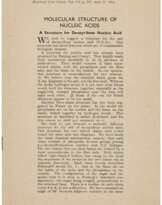ID 1032780
Lot 128 | The complementary structure of deoxyribonucleic acid
Estimate value
$ 2 000 – 3 000
The fourth, and longest, of Watson and Crick's jointly published papers on the structure of DNA. The initial discovery of the double-helix opened the floodgates to further crystallographic research to prove and explicate the discovery. In this paper Watson and Crick present their research from the past year and conclude: "The structure consists of two DNA chains wound helically round a common axis, and held together by hydrogen bonds between specific pairs of bases. The assumptions made in deriving the structure are described, and co-ordinates are given for the principal atoms. The structure of the crystalline form is discussed briefly" (abstract). This offprint belonged to Dr. Leonard Hamilton of Sloan-Kettering Institute of New York. Hamilton was a Cambridge-educated biochemist, just a few years younger than Francis Crick and Maurice Wilkins, with whom he was close friends. It was Hamilton who supplied the DNA specimens for Wilkins' lab to photograph.
Octavo (251 x 170mm). 8 conjugate leaves plus single leaf 9. 7 text illustrations plus one photographic plate with two figures. Self wrapper, stab-sewn with the last leaf tipped at left edge onto preceding page as issued (a little handling creasing and soiling). Provenance: Leonard D. Hamilton, 1921-2019 (ownership signature to front page).
| Artist: | Francis Crick (1916 - 2004) James Dewey Watson (1928) |
|---|---|
| Place of origin: | England, USA |
| Auction house category: | Printed books |
| Artist: | Francis Crick (1916 - 2004) James Dewey Watson (1928) |
|---|---|
| Place of origin: | England, USA |
| Auction house category: | Printed books |
| Address of auction |
CHRISTIE'S 20 Rockefeller Plaza 10020 New York USA | ||||||||||||||
|---|---|---|---|---|---|---|---|---|---|---|---|---|---|---|---|
| Preview |
| ||||||||||||||
| Phone | +1 212 636 2000 | ||||||||||||||
| Fax | +1 212 636 4930 | ||||||||||||||
| Conditions of purchase | Conditions of purchase | ||||||||||||||
| Shipping |
Postal service Courier service pickup by yourself | ||||||||||||||
| Payment methods |
Wire Transfer | ||||||||||||||
| Business hours | Business hours
|









